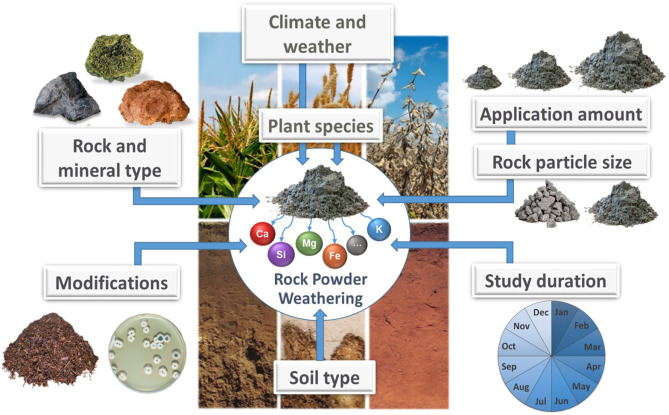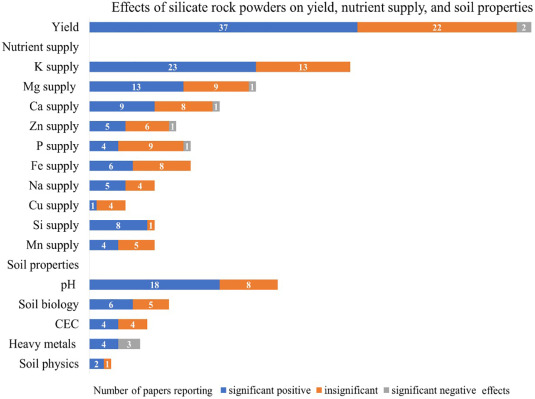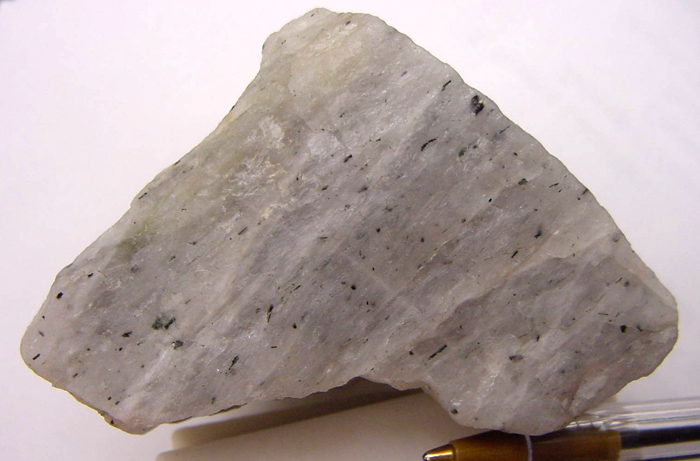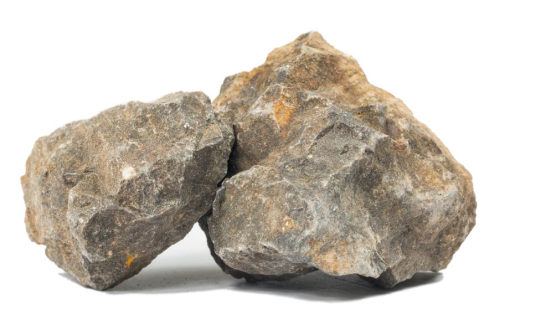Silicate Rock Power: Why it’s so important and why the world should care
Agriculture puts a high demand on soil nutrients, with subsequent soil depletion driving the fertilizer industry. Fortunately, silicate rock powder provides a sustainable macronutrient and micronutrient replacement, as explained in a recent literature review by Philipp Swoboda, Thomas F. Döring and Martin Hamer (Swoboda et al. 2022).
For example, silicate rock powders contain most of the nutrients — potassium specifically — that plants require (Deer et al. 2013). This is particularly important in tropical climates due to high depletion of soil nutrients and the economic inaccessibility to fertilizers in those regions, notably nitrogen, phosphorus, and potassium (van Straaten 2006). This soil depletion affects crop yield and nutrient content (Sanchez 2015).
Studies of silicate rock powder have measured whether it has properties that would make it an efficient NPK replacement for agrogeology, and the Swoboda et al. (2022) literary review encompassses several of these trials and studies on various types of silicate rocks. Researchers focused especially on weathering and mineralogy, climate and its impact on the consistency of experimental trials, and positive effects of silicate rock powders on plant yield, nutrient levels, and soil properties.
What makes silicate rock powder a good fertilizer?

Before looking directly at trials outcomes, Swoboda et al. (2022) had to look at the research methods in these studies. The components of the silicate rock powders used (and other factors) can influence their performance as fertilizers and thus must be accounted for in any comparisons.
The researchers observed that rock powder weathering influences fertilizer dissolution rates, while climate, particle size, and mineralogy (mineral components and structure) influence weathering. The smaller the particle, the more surface area is exposed to the soil and climate. This increases weathering and dissolution. Meanwhile, different minerals have different bonding strengths, which is associated with the structure within rocks that can influence how they weather.
Climate also plays a large role, with rainfall, temperature and storm exposure causing dynamic weathering patterns. Swoboda et al. (2022) found that these components combined with a dynamic climate can result in inconsistencies between laboratory results and field studies (Manning and Theodoro, 2020). Thus, key to the review is determining what we understand about experimental design and how it can produce inconsistencies to create a better foundation of knowledge for silicate rock powders.
Silicate rock powders, nutrient content and yield

As Swoboda et al. (2022) organized silicate rock powders by rock types while reviewing the studies, many of which had inconsistencies in their rock terminology, they made a distinction between rock structure and composition because this highly impacts the comparability of the studies.
They compared studies to observe the most significant impacts, both positive and negative, from using silicate rock powder as fertilizers, concluding crop potassium content increased with the use of such powders. As an example, Bakken et al. studies (1997 and 2000) found an increase in potassium uptake and yield when using silicate rock powder rich in nepheline — a feldspathoid mineral — and biotite.
A study in Argentina (Franzosi et al. 2014) compared glauconite and potassium chloride for yields, with the former having higher yields than the latter in five fields. These results correspond with the weathering rate of glauconite — the highest of all micas due to its mineral structure (Swoboda et al. 2022).
Further, a group in Malaysia found that adding basalt powder to the soil increased the yield of cacao plants, raising nutrient concentrations (Anda et al. 2013). Researchers also observed pH increases when using a basalt mixture in Austrian soils (Mersi et al. 1992).
In conclusion…

While there are still inconsistencies and knowledge gaps, these studies showcase the positive effects of utilizing silicate rock powder as a fertilizer. These powders effectively increase crop nutrient density, particularly in terms of potassium levels. Further, they increase the plant yield over time without additional applications of rock powders, while increasing soil pH to help replenish nutrients and aid plant growth (which is good for acidic soil regions).
The addition of silicate rock powders, which are more accessible in the tropical regions that need them most, will help to counteract the nutrient depletion and acidification of the soils to increase crop yields in tropical climates.
Elizabeth A Schuetz is a research technician working at North Carolina State University studying environmental contaminants effects on the circadian biology and the immune system. Her previous research focused on neuroscience studying epilepsy and neural circuitry. In her free time, she enjoys gardening, reading, hanging out with her dog, and exploring national parks and nature.
References
- Swoboda et al. 2022. Remineralizing soils? The agricultural usage of silicate rock powders: A review. Science of the Total Environment. 807.
- Deer, W.A., Howie, R.A., Zussman, J., 2013. An Introduction to the Rock-forming Minerals.3rd ed. The Mineralogical Society, London
- van Straaten, P., 2007. Agrogeology: The Use of Rocks for Crops. Enviroquest Ltd, Cambridge, Ontario Canada 440 p.
- Sanchez, P.A., 2015. En route to plentiful food production in Africa. Nat. Plants 1, 14014
- Manning, D.A., Theodoro, S.H., 2020.Enabling food security through use of local rocks and minerals. Ext. Ind. Soc. 7 (2), 480–487
- Bakken, A.K., Gautneb, H., Myhr, K., 1997.The potential of crushed rocks and mine tailing as slow-releasing K fertilizers assessed by intensive cropping with Italian ryegrass in different soil types. Nutr. Cycl. Agroecosyst. 47, 41–48.
- Bakken, A.K., Gautneb, H., Sveistrup, T., Myhr, K., 2000.Crushed rocks and mine tailings applied as K fertilizers on grassland. Nutr. Cycl. Agroecosyst. 56, 53–57.
- Franzosi, C., Castro, L.N., Celeda, A.M., 2014. Technical evaluation of glauconies as alternative potassium fertilizer from the Salamanca Formation, Patagonia, Southwest Argentina. Nat. Resour. Res. 23 (3), 311–320
- Anda, M., Shamshuddin, J., Fauziah, C.I., 2013. Increasing negative charge and nutrient contents of a highly weathered soil using basalt and rice husk to promote cocoa growth under field conditions. Soil Tillage Res. 132, 1–11
- Mersi, W.V., Kuhnert-Finkernagel, R., Schinner, F., 1992. The influence of rock powders on microbial activity of three forest soils. Z. P flanzenernaehr. Bodenk. 155 (1), 29–33
Support us on Patreon
Thank you for joining us today! Please become a member of RTE and support us on Patreon. Unlike many larger organizations, we work with a team of determined and passionate volunteers to get our message out. We aim to continue to increase the awareness of remineralization to initiate projects across the globe that remineralize soils, grow nutrient dense food, regenerate our forests’ and stabilize the climate – with your help! If you can, please support us on a monthly basis from just $2, rest assured that you are making a big impact every single month in support of our mission. Thank you!









Marcel Dingemans
September 2, 2022 (3:40 am)
How so would this be a sustainable option?
In my opinion it is yet another source we woud be going to extract from our already heavily damaged earth!
Destruct large areas to get minerals out of the earth to sell them to hold up an artificial growing system.
Instead of looking at nature what will sustain ITSELF! A food forest is a system most nature-like of the food systems, which will – after right implementation – doesn’t need any inputs after a few years.
THAT’S sustainable!
Every system growing annuals needs more input and keeps needing it.
Joanna Campe
September 4, 2022 (10:27 am)
We agree that food forests are a good model; RTE is an advocate for agroforestry systems to increase food security and resilience. A good example is Sitio Semente outside of Brasilia, which grows a great diversity of fruits, vegetables, coffee and cacao. Only one initial application of rock dust is needed, with no outside inputs thereafter.
Hard silicate rocks are the most abundant resource on Earth, and we already have millions upon millions of tons of rock dust available as byproduct, which is readily available. Over millennia the Earth regenerates soils through glaciation, volcanic eruptions and alluvial deposits. We can imitate nature and speed up that process to create a truly regenerative agriculture. This is a product that can replace chemical fertilizers for farmers, a product that has all the minerals and biologicals needed.